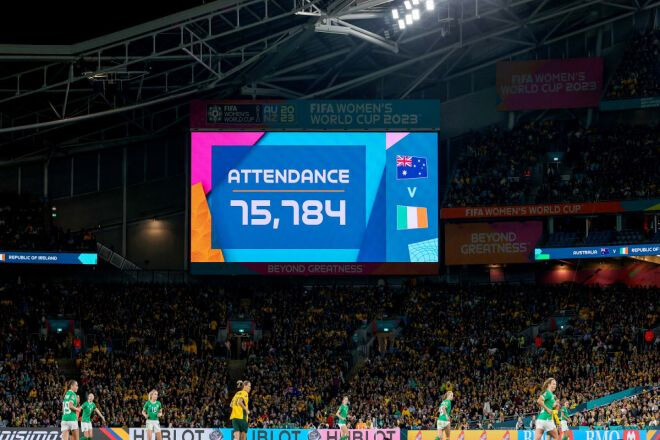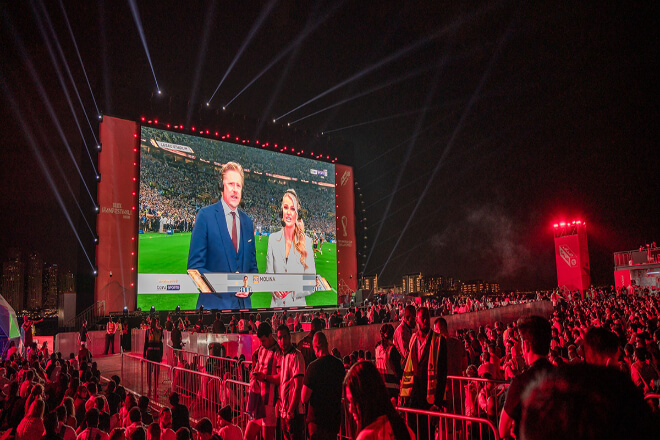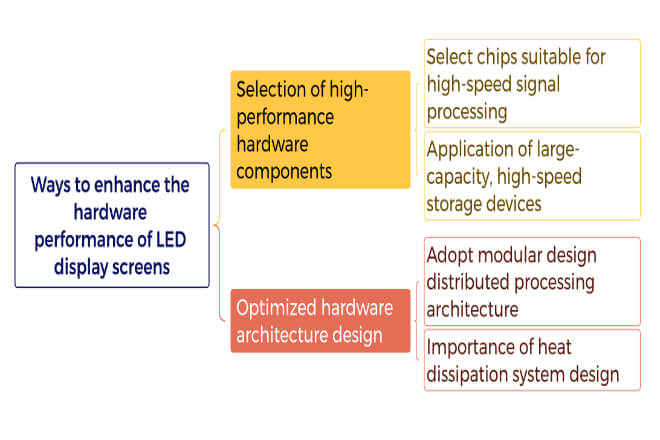介绍
When watching the live broadcast of major sports events, have you ever missed the wonderful moments and lost touch with the cheers of the audience due to the delay of the LED display screen?
This delay not only destroys the viewing experience but may also affect the commercial value and brand image of the event. So, how can we make the LED显示屏 broadcast the “World Cup” without delay?
目录
1. The current situation and impact of LED display screen broadcast delay

In today’s era of rapid information dissemination, the broadcast of major 运动的 events has long become the focus of global audiences.
As one of the important carriers of event broadcasts, the performance of LED display screens often makes people feel unsatisfactory, especially the problem of broadcast delay, which is a headache for countless viewers.
Taking the 2022 Qatar World Cup as an example, its live broadcast screen uses high-definition LED display technology, but there are still delay problems in some cases.
For example, when the referee replays the key penalty moments through the VAR system if there is a delay on the LED display screen, the audience may miss these wonderful moments and not understand the basis of the referee’s penalty in time.
This not only affects the audience’s viewing experience but also may cause the audience to be out of touch with the on-site audience and unable to feel the atmosphere and emotions of the scene synchronously.
In addition, in some large-scale sports events, the delay of LED display screens may also cause the audience to miss the wonderful performances of athletes.
For example, in track and field competitions, the audience may not be able to see the moment when the athletes cross the finish line in time, thus reducing the fun of watching.
2. Analysis of key factors leading to delays in LED display broadcasts

1). Signal transmission link
Wired transmission is like sending water through a pipe, and the network bandwidth is the thickness of the pipe.
If the pipe is too thin (insufficient bandwidth), the water (data) will flow slowly, and the audience will look at the screen like watching a slow-motion replay, and they will not catch up with any exciting moments.
Moreover, when transmitting data, if a data packet is “lost” (lost), it must be retrieved (retransmitted).
During this round trip, the picture on the screen is stuck, and the audience is so anxious!
Wireless transmission is even more complicated. Signal interference is like shouting in a noisy vegetable market.
There are too many sounds (other signals) around, and your shouting voice (your signal) is drowned out.
At large-scale sports events, the signals of various devices are crowded together, and the signals of LED display screens are easily interfered with, and the picture is either stuck or flickering.
There is also frequency band allocation, which is like assigning seats. Everyone wants to sit in a good seat (high-quality frequency band).
If it is not allocated well, several devices will be crowded together, and the signal transmission efficiency will be like a snail crawling, and the delay will rise.
Fiber optic transmission is like taking a highway; it is fast and stable, and the delay is almost negligible.
In some high-end event live broadcasts, optical fiber is used to transmit high-definition video, and the picture is as smooth as watching it on the spot.
Coaxial cable is worse, like taking an ordinary road, with higher delay than optical fiber, more interference, and the picture will occasionally freeze.
5G network is a new “high-speed player” with low latency and high speed, but the coverage has not been fully rolled out.
In some remote places, the signal is not good, the latency will become high, and the live broadcast effect will be greatly reduced.
2). Display hardware processing capabilities
LED display processing signals is like making a complex dish, which requires several processes.
First, the signal must be received, just like buying vegetables. If the quality of the vegetables (signals) is not good, the subsequent processes will be difficult.
Then, decoding is like cutting vegetables. If the knife (decoding chip) is not fast enough, the vegetables (signals) will be cut slowly.
Then, in image processing, like cooking, you have to adjust the heat (color correction, resolution adjustment, etc.).
If the heat is not well controlled (the image processing chip performance is insufficient), the dish (picture) will not be done well.
Finally, driving the display is like serving the dish on the table. If the speed of serving the dish is slow (the driving circuit responds slowly), the audience will have to wait with an empty stomach, watching the picture freeze, and they will be anxious!
If the processing chip of the display is slow, it is like using an old ox to pull a cart. The data processing is slow, and the audience looks like watching a slide show, which is very slow.
Small storage capacity is also troublesome, just like the storage space in the kitchen is not enough, there is no place to put the ingredients (data), and you are in a hurry when cooking (processing signals).
The picture is either stuck or flashing, which affects the viewing experience.
Different types of display screens are like different means of transportation, each with its own characteristics.
Indoor display screens are like cars, with high comfort but not suitable for complex outdoor environments.
Outdoor display screens are like off-road vehicles, which can resist wind, sand, and rain, but the speed (processing speed) and flexibility (storage capacity) may be worse.
The hardware configuration of display screens of different brands is also quite different.
The hardware configuration of display screens of big brands is like a luxury sports car, with strong performance and easy processing of high-definition video signals.
The hardware configuration of display screens of small brands may be like an old tractor, which is unable to process high-definition video signals and has obvious delays.
3). Software system and firmware compatibility issues
The control software, playback software, and firmware versions of the display are like a family. If they are not compatible (incompatible), there will be conflicts.
For example, the control software and playback software “fight” with each other, the command is sent, and the other party does not acknowledge it.
The signal processing is messed up, the picture is either stuck or flickering, and the audience is upset.
When the software processes the signal, it sometimes receives “disruptive” instructions (error instructions).
If the software cannot handle these disruptive instructions, the signal processing will be “stuck,” the picture will stop there, and the audience will be anxious and helpless.
If the software update is not updated well, or the software itself has design defects, then the problem is big.
For example, once a live broadcast of a sports event, the control software of the display screen was updated, and there was a design defect and signal processing delay.
The audience watched the picture freeze and missed many wonderful moments, and the commercial value and brand image of the event were affected.
3. Strategies to improve signal transmission efficiency to reduce latency

1). Optimize network transmission architecture
If you want the signal to be transmitted quickly and stably, you have to build a VIP channel for it.
For example, using a fiber optic dedicated line or a 5G private network is like opening a highway for the signal.
Fiber optic dedicated lines are the leaders in the transmission industry. They are fast and stable.
The signal runs very fast in them, and there is basically no lag. The latency is reduced immediately.
5G private networks are not bad, either. The speed is amazingly high. No matter how many high-definition video signals there are.
They can be easily handled so that the images seen by the audience are almost synchronized with the scene.
Let’s take a look at the layout of the network, which is also critical. If a star structure is used, it is like connecting all devices to a “brain.”
The “brain” directs the signal to be quickly distributed to each display screen. The transmission path is short, and the efficiency is naturally high.
The ring structure is also good. When the signal is running inside, if a node is “jammed,” it can also bypass it from another direction to ensure that the transmission will not be interrupted.
Network switches and routers also need to be configured properly, which is like setting up reasonable traffic lights and signs on the road.
Let the signal reach the destination quickly and accurately, avoid “traffic jams”, and the transmission efficiency will naturally improve.
2). Use advanced signal compression and transmission technology
The technology of compressing the signal data volume is like “losing weight” for the signal.
Efficient video encoding technology, such as H.265 and AV1, can compress huge amounts of data into a very small amount, but the image quality is almost unaffected.
It’s like compressing a large box into a small package, which is much more convenient to transport.
In this way, the demand for transmission bandwidth is reduced, and signal transmission is like a lightly equipped athlete running faster, and the delay is reduced.
There is also a data transmission protocol. Although the traditional TCP protocol is stable, the transmission delay is relatively high.
The UDP protocol is different. It is like an impatient courier who can deliver data packets quickly, greatly reducing the transmission time.
However, the UDP protocol has a small problem, that is, data loss may occur.
But don’t worry; through some technical means, such as data verification and retransmission mechanisms, the impact of data loss can be minimized while ensuring the transmission speed.
This is like a courier holding a list in his hand when delivering a package. If he finds that a package is lost, he will quickly send a replacement so that the signal transmission can be fast and stable, effectively reducing the delay.
4. Ways to enhance the hardware performance of LED display

1). Select high-performance hardware components
1.1). Select chips suitable for high-speed signal processing
To make the LED display process signals as fast as lightning, you have to choose a good “heart” – a high-performance chip.
This chip must be as powerful as the engine of a sports car, and the processing speed must be extremely fast.
The more cores, the better; just like having multiple workers working at the same time, the efficiency is naturally high.
The architecture must also be advanced, such as the latest multi-core architecture, which can make each link of signal processing seamlessly connected, just like the efficiency of assembly line operation.
With such a high-performance chip, the display is like taking “accelerators” when processing high-definition video signals, and the delay can be reduced to a very low level, and the audience can watch the picture as smoothly as a live broadcast.
1.2). Application of large-capacity, high-speed storage devices
Storage devices are like the “warehouse” of display screens. They must be able to hold a large amount of signal data and have fast access speeds.
Solid-state drives (SSDs) are a good choice. Their read and write speeds are much faster than traditional hard drives, and there is almost no delay in caching signal data.
It is like on a highway; vehicles (data) can quickly enter and exit toll booths (storage devices) without waiting in line.
With such high-speed storage devices, the display screen will not be stuck by storage bottlenecks when processing large amounts of data, and the delay will naturally be reduced.
2). Hardware architecture optimization design
2.1). Adopting modular design distributed processing architecture
The internal hardware architecture of the LED display screen should be as efficient as the city’s transportation network.
Adopting modular design, different functional modules are separated, and each module is responsible for a part of the work, just like the clear division of labor in each area of the city.
Distributed processing architecture is like setting up a processing center in each area; signal processing can be carried out in parallel, and efficiency is greatly improved.
It is like in a large-scale sports event, multiple referees work at the same time, instead of one referee handling everything, so that various signals can be processed quickly and delays can be reduced.
2.2). Importance of cooling system design
The cooling system is like the “air conditioner” of the display screen, which must ensure that the hardware does not “fever” under high load.
If the hardware overheats, just like a person with a fever, the performance will decrease, and the delay will increase.
A good cooling system can keep the hardware at the optimal operating temperature, just like athletes playing in a comfortable environment can play in the best state.
Therefore, the cooling system must be designed scientifically and reasonably so that the display screen can remain stable even when running at high load for a long time, avoiding performance problems caused by overheating.
5. 结论
Through the above comprehensive analysis of the delay of LED display screen broadcasting and the discussion of solution strategies, we see the hope of achieving delay-free broadcasting.
Whether it is optimizing the network transmission architecture, improving hardware performance, or adopting advanced signal compression technology, every step is crucial. I hope that sharing this article can inspire you.
最后,如果你想了解更多关于LED显示屏的信息, 请与我们联系。
